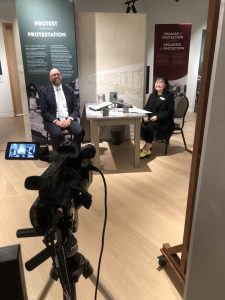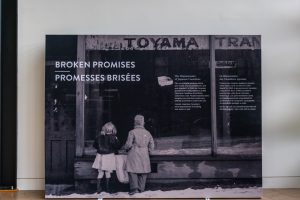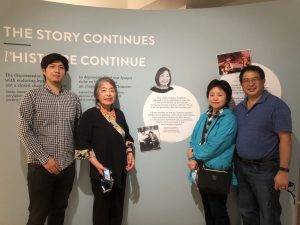Landscapes of Injustice Launch Event Oct 2020
Landscapes of Injustice Museum Launch Event
A culmination of a seven year research project on the dispossession of Japanese Canadians in the 1940s
By Michael Abe
On Saturday, September 26, 2020, the Landscapes of Injustice research project held a live-streaming event to launch Broken Promises, the new travelling museum exhibit at the Nikkei National Museum & Cultural Centre. We want to thank the over 320 viewers who watched it in real time, as well as over 3,800 views in the next five days. https://www.youtube.com/watch?v=qdhlzDr1Jwk
Photo courtesy: Michael Abe
It was a huge moment for our project, unveiling not only the museum exhibit, but also the release of our narrative website and teacher resources websites.
For links to the event launch, the websites and also the e-catalogue for Broken Promises, please visit www.landscapesofinjustice.com.
Photo courtesy: Kayla Isomura
Our last major project output, the digital archives database, will be launched in early 2021 and will provide easier access to documents and records acquired by the project pertaining to Japanese Canadians during the Internment Era. We hope that this will be an important feature that will benefit members of the community as they explore their family history as well as for researchers interested in this topic.
We also hope that the contents in the database will inspire intergenerational exploration of family histories. Leading up to the museum event, Project Manager, Michael Abe and Research Assistant Natsuki Abe talked with Rohit Joseph on CBC Radio All Points West about how their family history has and hasn’t been passed down and how they are using the research from Landscapes of Injustice to learn more about their family and heritage. Natsuki, a yonsei, poignantly tells the story of how she first learned of her family story on a trip to New Denver with her grandparents.
You can listen to the interview on https://www.cbc.ca/listen/live-radio/1-93-all-points-west/clip/15800138-new-uvic-led-museum-exhibit-shines-light-untold-stories
And while introducing a short video on the digital archive database during the museum exhibit launch event, Landscapes of Injustice Community Council chair, Vivian Wakabayashi Rygnestad, spoke about how she discovered things about her father from the project that she had never know before.
Here is her talk in its entirety, courtesy of Vivian.
The Community Council was established by the Landscapes of Injustice project to act in an advisory role to its researchers. Our nine members were Japanese Canadians chosen from across Canada.
As a group and often with the researchers, we had many discussions on topics such as terminology, euphemisms, and the ethics of gathering, storing and using oral histories.
As Japanese Canadians, we knew stories from our own experiences or from our families. This was our opportunity to learn from and to have stories confirmed by government records, letters, oral histories, and other items unearthed by research.
Thank you to the Landscapes of Injustice project for the opportunity to represent the Japanese Canadian community in this study of the racism, forced uprooting, internment, and dispossession that completely changed the lives of thousands of Canadians of Japanese heritage.
Thank you to Jordan Stanger-Ross for his vision and commitment to the study of Japanese Canadian dispossession. The results of the project include a narrative website, digital archives database, teacher resources, the museum exhibit, and the Landscapes of Injustice book. Equally important are the many researchers and students who are furthering their studies and careers in areas of history and social justice.
This is not just Japanese Canadian history. This is Canadian history.
As the chair of the Community Council, I thank Art Miki, Sally Ito, Jennifer Hashimoto, Norm lbuki, Mary and Tosh Kitagawa, Susanne Tabata and Eiko Eby for their commitment to ensuring that the voices of Japanese Canadians were always an integral part of the project.
On a personal level, I was not only learning about Japanese Canadian history in general. .. it was causing me to reflect deeply on the lives of my parents and grandparents.
I was born during the internment and over the years my parents guided, encouraged, and supported me. They didn’t talk much about the internment years, and I didn’t know enough to ask.
One day I received an email from Eric and Jordan – a draft of a paper they were writing, and asked my opinion. In the second sentence I read “Tadao Wakabayashi”. I immediately emailed back with “that’s my father’s name … ls there someone else with the same name”? Immediately I got the answer … yes it was my father.
I didn’t know that in 1944, my father, along with Eikichi Nakashima, Jitaro Tanaka and their lawyer, J. Arthur MacLennan went to Ottawa to protest the government’s broken promise that led to the sale of everything left behind, left in trust, by 22,000 Japanese Canadians.
I was proud of my father for being one of the men chosen to confront the Prime Minister about the broken promise.
This caused me to begin reflecting more deeply and to appreciate even more the sacrifices, hard work, resilience, courage, and positive attitudes and actions of my parents. With them as guides, I learned the values of family, service, leadership, education, kindness, and compassion. I learned about social justice – and the importance of taking a stand.
I learned more when I received files on my family from the digital archives data base. Reading through the government files revealed the official losses of home, businesses, vehicles, and household items that had been left behind … taken. Sold.
There are times when I find myself thinking “I wish … l wish I had talked more with my parents. I wish they were still here so I could ask them”.
It’s easy to blame our parents for not telling us…for not talking about their experiences around internment. Silence. There are so many reasons for the silence – guilt, shame, anger, shi-kata-ga-nai…
We can change the silence around the racism, the social injustices and the internment by Canada of its own citizens.
We need to start by educating ourselves and others about this dark part of Canadian history … and we can begin by telling our own family stories to our children.
Thank you.
Photo courtesy: Michael Abe l-r Kento Abe, Vivian Rygnestad, Izumi and Michael Abe



